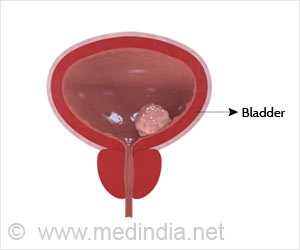A protein recently linked to cancer has a significant effect on the spreading the cancer, but lowering the protein level in cell cultures and mice reduces the spread of cancer beyond tumor.

In a new study published in the journal PLOS ONE, the researchers reported similar findings in animals. The study showed that mice implanted with breast cancer cells lacking the protein developed small, self-contained tumors consisting of cells that didn't leave the tumor. In contrast, mice implanted with cancer cells containing the protein developed larger, irregular masses and showed signs that cancer cells had invaded the surrounding tissue.
The research suggests that reducing production of the protein, called myoferlin, affects cancer cells in two primary ways: by changing the activation of many genes involved in metastasis in favor of normal cell behavior, and by altering mechanical properties of cancer cells - including their shape and ability to invade - so they are more likely to remain nested together rather than breaking away to travel to other tissues.
Myoferlin's influence on both molecular and mechanical processes in breast cancer cells suggests that diagnostic methods and perhaps even treatments eventually might be tailored to patients based on protein levels and mechanical properties in cells detected in tumors, researchers say. Though clinical applications are still years away, the scientists say the two-pronged approach to research on the protein''s effects broadens its potential usefulness in diagnostics and therapies.
"Theoretically, if a patient had a tumor in which the myoferlin level was low, it would be defined as small and a surgeon could remove it and it wouldn't metastasize. That's the nodule type of tumor we saw in the mice with the silenced protein," said Douglas Kniss, professor of obstetrics and gynecology at Ohio State's Wexner Medical Center and senior author of the study.
Kniss and colleagues used subtypes of triple-negative breast cancer cells for the study - one of the most lethal forms of breast cancer because of its likelihood to spread. "Since triple-negative cells are the most dangerous, we do wonder if this protein is relevant to only the most dangerous types of cancers, or if it is more generalized. We don't know the answer at the moment," he said.
Advertisement
"We're seeing now that the mechanics are going to drive whether cancer cells can migrate faster or slower or break away or not. The mechanics have the possibility of being a more specific diagnostic marker," Ghadiali said.
Advertisement
"We had guilt by suspicion," said Kniss, also director of the Laboratory of Perinatal Research at Ohio State. "So we decided to knock out the gene for myoferlin in breast cancer cells and the cells did weird things. They didn''t invade very well."
At the core of this cell behavior is how the loss of that single gene changes activation levels of dozens of other genes, suppressing genes associated with metastatic disease and increasing activity of genes linked to normal tissue. But the cells also changed shape and other properties in the absence of the protein in ways that reduced the likelihood that they would travel away from the tumor - a sign that myoferlin not only changes genes in cancer cells, but also alters the cells' mechanical properties.
In this most recent study, the researchers analyzed the various mechanical changes to breast cancer cells in which myoferlin levels were dramatically reduced compared to normal breast cancer cells. The scientists used a modified virus to deliver pieces of RNA to block the myoferlin gene.
When the protein is present, these cells that start out round and stuck together in a pattern resembling cobblestones become irregularly shaped and tend to detach from the tumor site in an uncoordinated way - hallmarks of metastasis. They also lose their "stickiness," or adhesion property, making it easier for them to break away from neighboring cells.
In contrast, cancer cells lacking the protein tend to retain their usual shape and stickiness, and stay together in a group if they make any movement - all features that would cause a tumor to remain intact for surgical removal.
The most surprising mechanics-related finding concerned the cells' stiffness. The prevailing theory about metastatic disease suggests that metastatic cancer cells must be soft, or pliable like Play-Doh, to squeeze through tissue, blood vessels and more tissue as they travel to and invade distant locations in the body. But the tumor cells containing normal levels of myoferlin - the cells likely to migrate - were found to be stiff rather than soft, similar to hardened modeling clay.
So the new thinking is that under typical metastatic conditions, the cells must initially stiffen up to make it possible to leave the tumor, and then soften to ease their travels through the body, said Ghadiali, also an investigator in the Davis Heart and Lung Research Institute.
"We believe the cells lacking myoferlin are made softer in the tumor so they can't physically detach away. So making cells in the primary tumor softer might be a way to prevent metastasis," he said. "And that suggests that seeing softer cells in circulation means it''s almost too late. You've already got some advanced disease going on."
This is the third related study published by the Ohio State team. Kniss is either an author or a peer reviewer of the five most recent studies about myoferlin''s link to cancer.
The researchers next will turn to analyzing the presence of myoferlin in samples from numerous human tumor types available in an Ohio State tissue bank, which will allow them to compare protein levels in tumors to clinical outcomes for the patients who provided the samples.
This work was supported by the National Science Foundation and the Ohio State University Perinatal Research and Development Fund.
Co-authors include Leonithas Volakis, Cosmin Mihai (now with Pacific Northwest National Laboratory), Christopher Ahn (now with the University of California, San Diego), Heather Powell (now with Ohio State's Department of Mechanical Engineering) and Rachel Zielinski of Ohio State's Department of Biomedical Engineering; Ruth Li, William Ackerman IV, Meagan Bechel (now with Northwestern University) and Taryn Summerfield of Ohio State's Department of Obstetrics and Gynecology; and Thomas Rosol of Ohio State's Department of Veterinary Biosciences.
Source-Newswise















